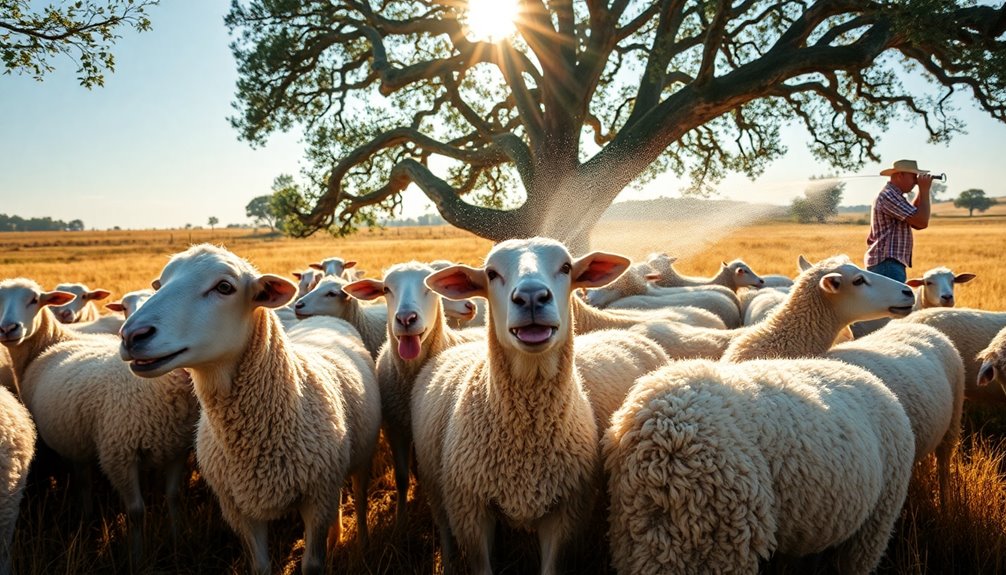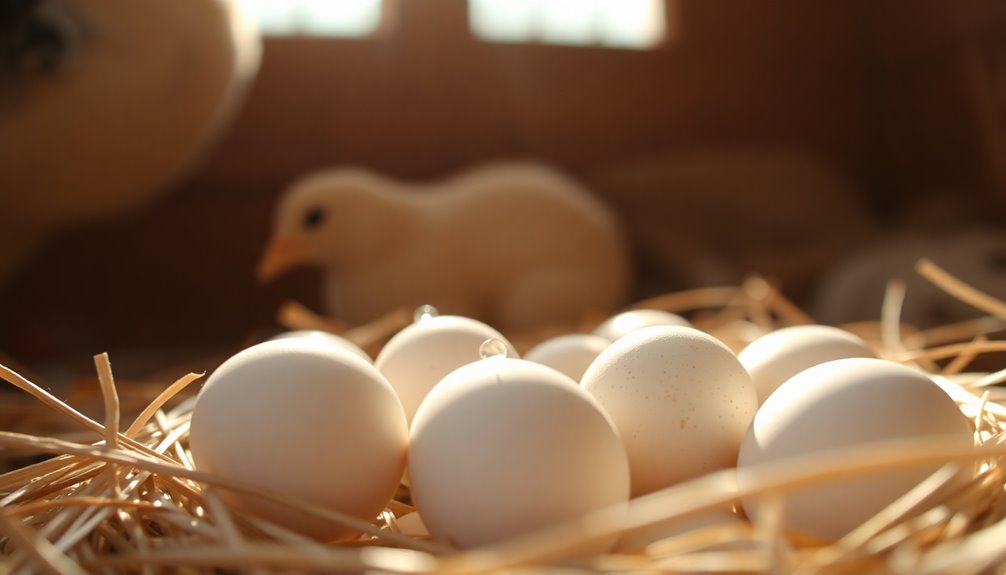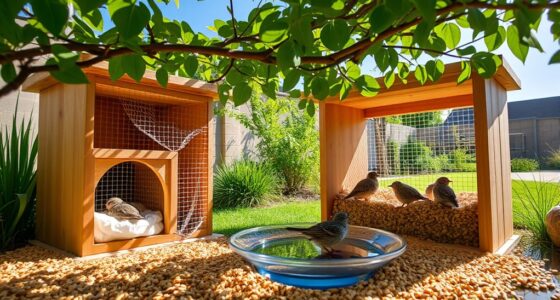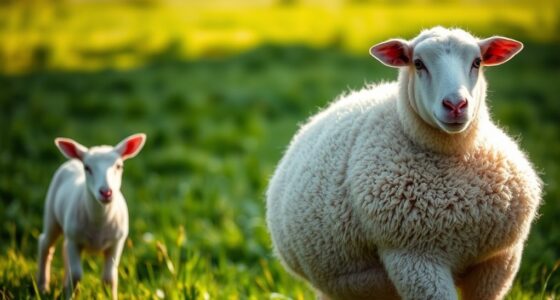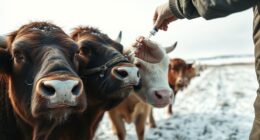Heat stress can drastically affect your flock's health. You'll want to keep an eye out for rapid panting, decreased grazing, and behavioral changes like seeking shade more often. Providing adequate shade and clean water is vital; position water troughs in shaded areas to encourage drinking. Adjust feeding schedules to cooler times, and consider including grains for a lighter heat load. Monitor your sheep's body temperature, and be aware of when it exceeds 105°F. By implementing these strategies, you'll enhance your flock's well-being and productivity. Discover more effective management techniques to guarantee your sheep stay cool and healthy.
Key Takeaways
- Monitor heat stress symptoms like rapid panting, decreased grazing, and elevated body temperatures to ensure timely intervention.
- Provide adequate shade and shelter to enhance animal comfort and reduce competition for shaded areas during hot weather.
- Ensure access to clean, cool water in shaded locations, and consider adding electrolytes to aid hydration during extreme heat.
- Adjust feeding practices by shifting feeding times to cooler parts of the day and incorporating energy-dense diets to minimize heat production.
- Utilize technology solutions for weather monitoring and behavioral observation to implement effective heat management strategies and improve animal welfare.
Recognizing Heat Stress Symptoms
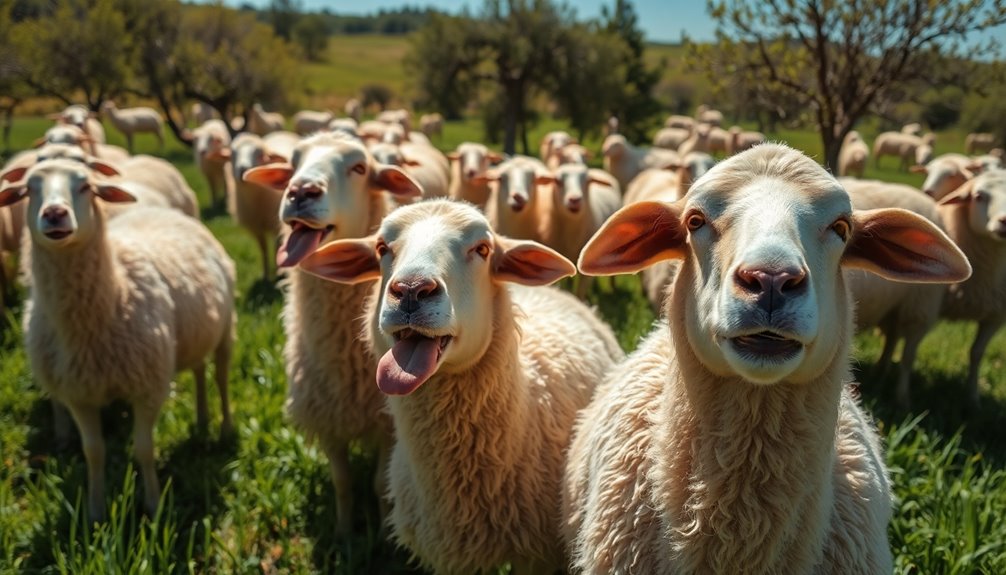
Often, you'll notice signs of heat stress in sheep before it escalates into a serious issue.
Keep an eye out for rapid panting or heavy breathing, often with an open mouth and extended tongue, which indicates severe heat stress.
Behavioral signs like increased crowding at water sources and frequent seeking of shade show their need for hydration and relief from high temperatures.
You might also observe a decrease in grazing time and feed intake, along with lethargy, signaling heat stress.
Monitoring their body temperature is vital; anything above 105°F is concerning, especially if it exceeds 107°F.
Additionally, changes in grazing patterns, such as shifting to early morning or late evening, reflect their struggle to cope with the heat.
Importance of Shade and Shelter
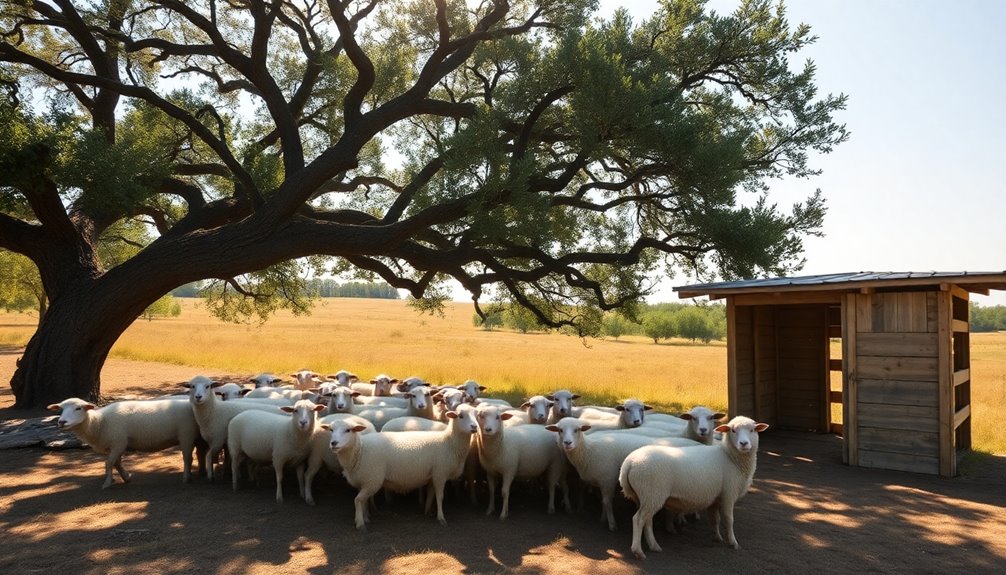
When it comes to keeping your sheep comfortable, shade and shelter are essential.
Natural shade from trees offers the best relief, but portable shade solutions can help during those intense heat waves.
For a long-term fix, consider installing permanent structures that enhance airflow and protect your flock from extreme temperatures.
Natural Shade Preferences
Shade plays an essential role in managing heat stress in sheep, as natural cover from trees effectively shields them from direct sunlight.
Providing adequate shade not only enhances animal comfort but also lowers ambient temperatures.
Sheep and goats instinctively seek natural shade, indicating their need for cooler environments during high temperatures.
By ensuring access to shade, you improve animal welfare and reduce competition for shaded areas, allowing better distribution among your flock.
While natural shade is ideal, consider installing shade structures like portable shade cloths or permanent shelters for extra protection.
With sufficient shaded areas, your animals are more likely to remain active and maintain their feed intake, promoting overall health and well-being in your flock.
Portable Shade Solutions
Portable shade solutions are essential for providing immediate relief to sheep during hot weather. By using these structures, you can effectively reduce sun exposure and lower ambient temperatures, which helps combat heat stress.
Consider installing reflective materials that enhance airflow, creating a cooler environment for your flock. Regularly evaluate the effectiveness of your shade structures to guarantee they offer adequate heat-related protection.
Strategically placing portable shade options near water sources encourages your sheep to seek shelter, promoting increased water intake and improved hydration during extreme heat events.
This proactive approach greatly reduces the risk of livestock distress, keeping your flock comfortable and healthy throughout the sweltering days. Prioritize these solutions to safeguard your sheep against the harmful effects of heat.
Permanent Shelter Structures
Having adequate permanent shelter structures is crucial for managing heat stress in sheep. These structures, equipped with adequate ventilation, greatly enhance airflow, allowing cooler air to circulate and facilitating heat dissipation.
Installing shade structures made from reflective materials can lower ambient temperatures, providing essential relief from direct sunlight and improving animal comfort. Natural shade from trees is also preferable, as it protects sheep from sun exposure while maintaining cooler ground temperatures beneath the canopy.
Regular evaluation of these shelters is necessary to guarantee they meet your flock's needs during extreme heat. Strategically placing permanent shelters helps minimize competition for shade, improving sheep's ability to find refuge from high temperatures and maintain hydration levels.
Providing Clean Water Access
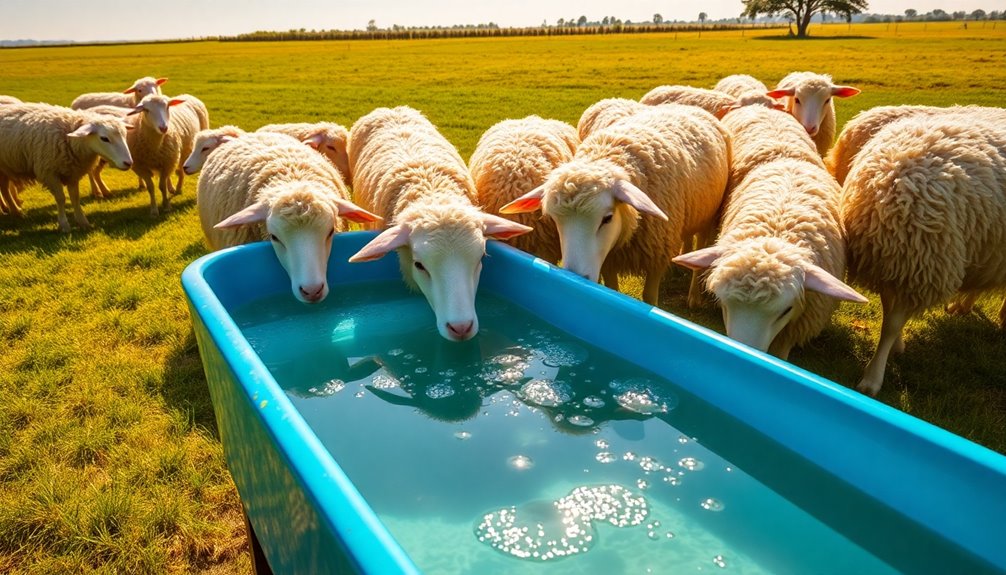
To keep your sheep hydrated during hot weather, place water troughs in shaded areas to encourage regular drinking.
It's essential to clean and refill these containers regularly, ensuring they provide fresh water free from algae.
Consider adding electrolytes during extreme heat to help your animals manage their hydration and body temperature effectively.
Water Source Placement
When managing heat stress in sheep, ensuring access to clean water is crucial for their hydration and overall health.
Position water troughs in shaded areas to keep water temperatures cooler, encouraging sheep to drink more. During hot weather, they need 1-2 gallons of water daily, so larger troughs are advisable to reduce competition and promote consistent hydration.
Providing multiple water sources can alleviate crowding at troughs, especially during peak heat times when sheep are actively seeking hydration.
Regular monitoring of water availability and quality is important; fresh water helps regulate body temperature and mitigates the effects of heat stress.
Your proactive approach to water source placement will greatly benefit your flock's well-being.
Regular Cleaning Protocols
Positioning water troughs in shaded areas is just the beginning of ensuring your sheep have access to clean water.
Regularly cleaning these troughs is essential to prevent algae growth, which can compromise water quality and deter drinking.
During summer heat, monitor the water supply daily to guarantee your flock drinks the recommended 1-2 gallons per day.
Larger troughs can help minimize competition, allowing all sheep to hydrate as needed.
Implement a cleaning schedule to sanitize and refill water containers regularly, promoting hydration and preventing dehydration.
Good flock management means prioritizing clean water access, especially during heat stress, so take these steps seriously to keep your sheep healthy and comfortable throughout the hot months.
Electrolyte Supplementation Benefits
While ensuring your sheep have access to clean water is essential, supplementing it with electrolytes can markedly enhance their hydration and recovery during heat stress.
Electrolyte supplementation helps replenish lost minerals due to increased sweating and respiration, important for maintaining hydration. During extreme heat, heat-stressed sheep may boost their daily water intake by about 65%.
This improved water consumption not only supports their health but also enhances performance and feed intake. It's especially beneficial for young, lactating sheep, who are more vulnerable to dehydration effects.
Regularly monitoring water sources and ensuring fresh, palatable electrolyte solutions can make a significant difference in keeping your flock hydrated and healthy throughout the challenging heat stress periods.
Feeding Adjustments for Hot Weather
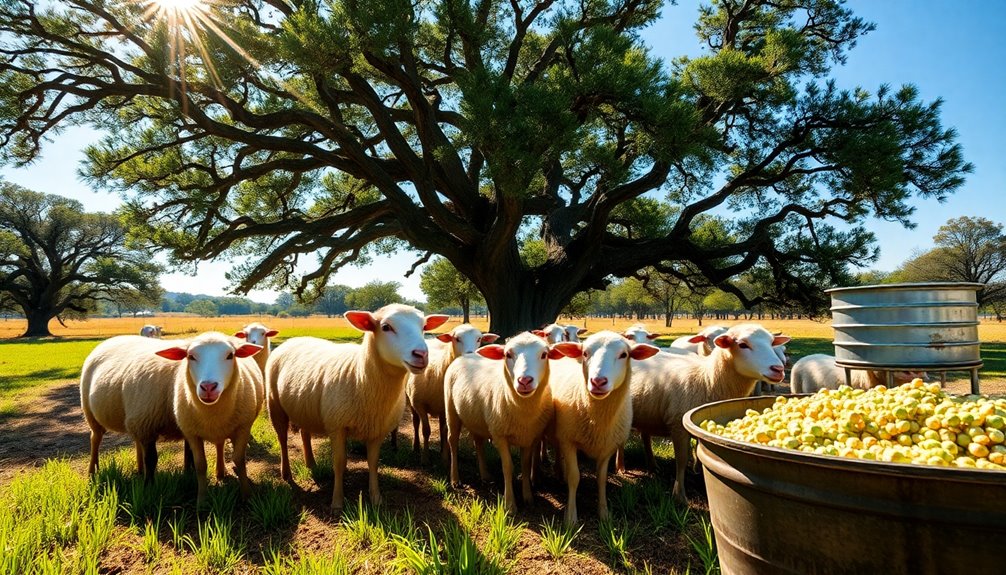
To effectively manage heat stress in sheep, making strategic feeding adjustments during hot weather is vital.
Start by shifting feeding times to cooler parts of the day, like early morning or evening, to reduce metabolic heat production during digestion.
Since heat-stressed sheep may reduce feed intake, increase the energy density of their diets by incorporating grains, which produce less body heat than forages.
Fresh, high-quality forage is essential; it stimulates consumption and encourages them to choose more palatable feed options.
Additionally, adding fats to the diet provides necessary energy without generating excess metabolic heat.
Finally, promptly removing uneaten feed keeps your flock's diet fresh and appetizing, further encouraging intake during these challenging conditions.
Grazing Management Strategies
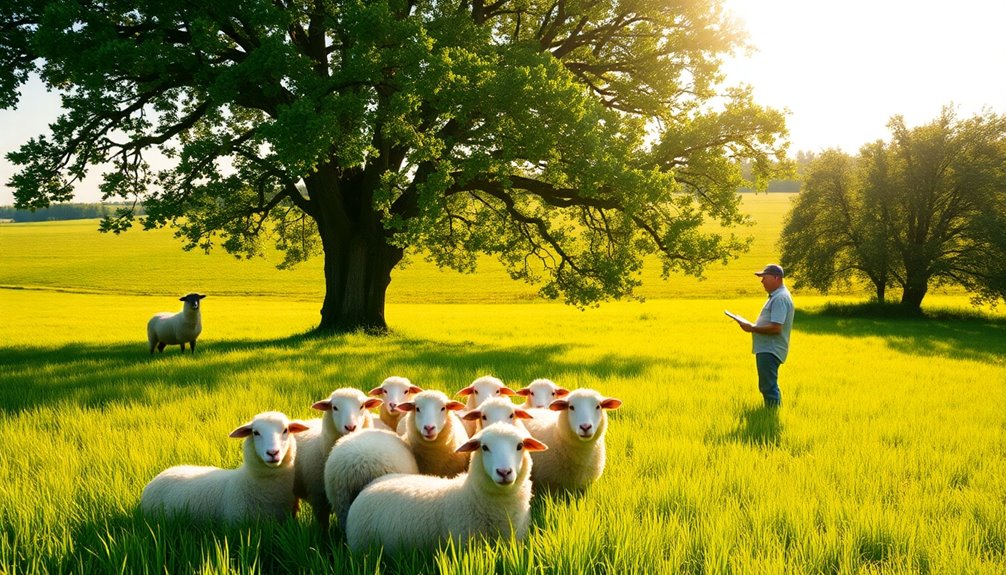
Effective grazing management strategies are essential for minimizing heat stress in sheep during hot weather.
Implement rotational grazing to give your flock access to fresh pasture while limiting their time in direct sunlight. Schedule grazing for cooler hours, like early morning and late evening, to help maintain feed intake and comfort.
Make certain your sheep have access to paddocks with natural shade, allowing them to graze while reducing heat exposure during peak temperatures. During extreme heat waves, consider night grazing to take advantage of cooler nighttime temperatures, promoting better animal welfare.
Additionally, adjust your grazing schedules based on weather forecasts and temperature trends to maintain ideal conditions for your flock and keep them healthy.
Technology for Heat Stress Monitoring
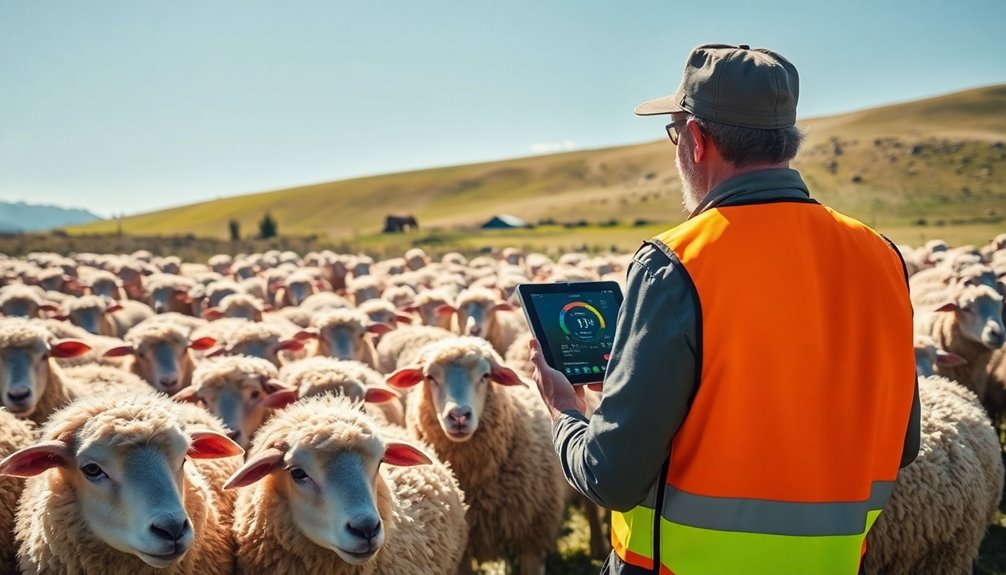
Monitoring heat stress in sheep has become increasingly essential as climate conditions intensify.
Fortunately, technology can help you manage this challenge effectively. Here are some innovative tools to evaluate:
- Weather monitoring systems for real-time temperature and humidity tracking.
- Automated misting and cooling systems that provide comfort during extreme heat.
- Remote monitoring cameras to observe animal behavior and detect heat stress early.
- AI advisory systems analyzing pasture health for informed livestock management.
Frequently Asked Questions
How to Reduce Heat Stress in Sheep?
To reduce heat stress in your sheep, provide plenty of shade, either from natural trees or constructed structures, to keep them cool.
Make sure they always have access to clean, cool water, placing troughs in shaded areas.
Adjust your feeding schedule to cooler times of the day and consider rotational grazing to give them fresh pasture while ensuring shaded resting spots.
Additionally, use fans or misters in barns to improve air circulation.
What Are the Four Stages of Heat Exhaustion?
When it comes to heat exhaustion in sheep, you'll notice four distinct stages.
First, there's mild heat stress, where you see increased panting and reduced feed intake.
Next, moderate heat stress shows open-mouth panting and a further decrease in feed consumption.
As heat stress progresses to severe, you may observe signs like lethargy and a significant drop in water intake.
Finally, in the extreme stage, sheep can experience collapse and even death if not addressed promptly.
How to Keep Hair Sheep Cool in Summer?
To keep your hair sheep cool in summer, provide plenty of shade, either from trees or portable structures.
Make sure they've access to clean, cool water in shaded areas to encourage hydration.
Adjust their feeding schedule to cooler times, like early mornings or evenings, to reduce heat production.
You can also use misting systems or fans in their shelters to enhance airflow and comfort during the hottest parts of the day.
How Do You Reduce Stress in Sheep?
Imagine you're managing a flock on a hot summer day. To reduce stress in your sheep, you can provide ample shade through trees or structures. This keeps them cool and comfortable, preventing heat-related issues.
Also, adjust feeding times to early mornings or evenings when it's cooler, and guarantee they've constant access to fresh, clean water. By making these changes, you'll promote a healthier, more relaxed flock throughout the warm months.
Conclusion
Just like a shepherd guides their flock through a scorching desert, you too can lead your sheep to comfort in the heat. By recognizing the signs of distress and providing shelter, water, and proper nutrition, you create an oasis for your animals. Embrace modern tools to keep an eye on their well-being, ensuring they thrive even under the blazing sun. Remember, a well-cared-for flock is a happy flock, ready to graze and grow in harmony with the seasons.

